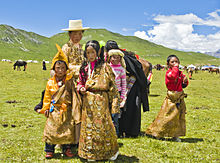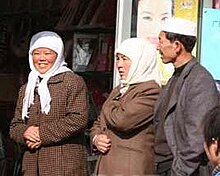Chinese people

Portion of a mural in Beijing depicting the 56 recognized ethnic groups of China
Chinese people are the various individuals or ethnic groups associated with China,[1] usually through ancestry, ethnicity, nationality, citizenship or other affiliation. Han people, the largest ethnic group in China, at about 92% of the population,[2] are often referred to as "Chinese" or "ethnic Chinese" in English,[3][4] however there are dozens of other related and unrelated ethnic groups in China.
Contents
1 Ancestry
2 Nationality, citizenship and residence
3 Overseas Chinese
4 See also
5 References
6 External links
Ancestry

Woman wearing yellow and green hanfu, a traditional dress of the Han Chinese.

Tibetans in Qinghai

Hui people in Xinjiang
A number of ethnic groups within China, as well as people elsewhere with ancestry in the region, may be referred to as Chinese people.[5]
Han people, the largest ethnic group in China, are often referred to as "Chinese" or "ethnic Chinese" in English.[6][3][4] The Han also form a majority or notable minority in other countries, and may comprise as much as 19% of the global human population.[7]
Other ethnic groups in China include the related Hui people or "Chinese Muslims", the Zhuang, Manchu, Uyghurs and Miao, who make up the five largest ethnic minorities in mainland China with populations exceeding 10 million. In addition, the Yi, Tujia, Tibetans and Mongols each number populations between six and nine million.
The People's Republic of China (PRC) officially recognizes 56 distinct ethnic groups, many of whom live in the special administrative regions of the country. However, there exists several smaller ethnicities who are "unrecognized" or subsumed as part another ethnic group. The Republic of China (ROC or commonly Taiwan) officially recognizes 14 tribes of Taiwanese aborigines, who together with unrecognized tribes comprise about 2% of the country's population.[8]
During the Qing dynasty the term "Chinese people" (Chinese: 中國之人 Zhōngguó zhī rén; Manchu: Dulimbai gurun i niyalma) was used by the Qing government to refer to all subjects of the empire, including Han, Manchu, and Mongols.[9]
Zhonghua minzu (simplified Chinese: 中华民族; traditional Chinese: 中華民族; pinyin: Zhōnghuá Mínzú), the "Chinese nation", is a supra-ethnic concept which includes all 56 ethnic groups living in China that are officially recognized by the government of the People's Republic of China. It includes established ethnic groups who have lived within the borders of China since at least the Qing Dynasty (1644–1911).[10] The term zhonghua minzu was used during the Republic of China from 1911–1949 to refer to a subset of five ethnic groups in China.[11] The term zhongguo renmin (Chinese: 中国人民), "Chinese people", was the government's preferred term during the life of Mao Zedong; zhonghua minzu is more common in recent decades.[12]
Nationality, citizenship and residence
The Nationality law of the People's Republic of China regulates nationality within the PRC. A person obtains nationality either by birth when at least one parent is of Chinese nationality or by naturalization. All people holding nationality of the People's Republic of China are citizens of the Republic.[13] The Resident Identity Card is the official form of identification for residents of the People's Republic of China.
Within the People's Republic of China, a Hong Kong Special Administrative Region passport or Macao Special Administrative Region passport may be issued to permanent residents of Hong Kong or Macao, respectively.
The Nationality law of the Republic of China regulates nationality within the Republic of China (Taiwan). A person obtains nationality either by birth or by naturalization. A person with at least one parent who is a national of the Republic of China, or born in the ROC to stateless parents qualifies for nationality by birth.[14]
The National Identification Card is an identity document issued to people who have household registration in Taiwan. The Resident Certificate is an identification card issued to residents of the Republic of China who do not hold a National Identification Card.
The relationship between Taiwanese nationality and Chinese nationality is disputed.[15]
Overseas Chinese
Overseas Chinese refers to people of Chinese ethnicity or national heritage who live outside the People's Republic of China or Taiwan as the result of the continuing diaspora.[16] People with one or more Chinese ancestors may consider themselves overseas Chinese.[17] Such people vary widely in terms of cultural assimilation. In some areas throughout the world ethnic enclaves known as Chinatowns are home to populations of Chinese ancestry.
In Southeast Asia, Chinese people call themselves 華人 (Huárén), which is distinguished from (中國人) (Zhōngguórén) or the citizens of the People's Republic of China or the Republic of China.[18] This is especially so in the Chinese communities of Southeast Asia. The term Zhongguoren has a more political or ideological aspect in its use; while many in China may use Zhongguoren to mean the Chinese ethnicity, some in Taiwan would refuse to be called Zhongguoren.[19]
See also
For countries with significant populations
- Chinese Malaysian
- Chinese Singaporean
For countries with noteworthy populations
- Chinese Thai
- Chinese Filipino
- Chinese Australian
- Chinese Canadian
- Chinese New Zealander
Other countries with Chinese populations
- Chinese American
- Chinese Indonesian
- Chinese Vietnamese
- Chinese Cambodian
- Chinese Russian
- British Chinese
- Chinese Caribbean
- Chinese Cuban
- Chinese Guyanese
- Chinese Jamaican
- Chinese Trinidadian and Tobagonian
- Chinese Surinamese
- Chinese Brazilian
- Chinese Argentine
- Chinese Mexican
- Chinese Venezuelan
Related topics of interest
- Chinese nationality
- Ethnic minorities in China
- Unrecognized ethnic groups in China
- Chinese Americans in New York City
References
^ Harding, Harry (1993). "The Concept of "greater China": Themes, Variations and Reservations". The China Quarterly (136): 660–86. JSTOR 655587..mw-parser-output cite.citationfont-style:inherit.mw-parser-output .citation qquotes:"""""""'""'".mw-parser-output .citation .cs1-lock-free abackground:url("//upload.wikimedia.org/wikipedia/commons/thumb/6/65/Lock-green.svg/9px-Lock-green.svg.png")no-repeat;background-position:right .1em center.mw-parser-output .citation .cs1-lock-limited a,.mw-parser-output .citation .cs1-lock-registration abackground:url("//upload.wikimedia.org/wikipedia/commons/thumb/d/d6/Lock-gray-alt-2.svg/9px-Lock-gray-alt-2.svg.png")no-repeat;background-position:right .1em center.mw-parser-output .citation .cs1-lock-subscription abackground:url("//upload.wikimedia.org/wikipedia/commons/thumb/a/aa/Lock-red-alt-2.svg/9px-Lock-red-alt-2.svg.png")no-repeat;background-position:right .1em center.mw-parser-output .cs1-subscription,.mw-parser-output .cs1-registrationcolor:#555.mw-parser-output .cs1-subscription span,.mw-parser-output .cs1-registration spanborder-bottom:1px dotted;cursor:help.mw-parser-output .cs1-ws-icon abackground:url("//upload.wikimedia.org/wikipedia/commons/thumb/4/4c/Wikisource-logo.svg/12px-Wikisource-logo.svg.png")no-repeat;background-position:right .1em center.mw-parser-output code.cs1-codecolor:inherit;background:inherit;border:inherit;padding:inherit.mw-parser-output .cs1-hidden-errordisplay:none;font-size:100%.mw-parser-output .cs1-visible-errorfont-size:100%.mw-parser-output .cs1-maintdisplay:none;color:#33aa33;margin-left:0.3em.mw-parser-output .cs1-subscription,.mw-parser-output .cs1-registration,.mw-parser-output .cs1-formatfont-size:95%.mw-parser-output .cs1-kern-left,.mw-parser-output .cs1-kern-wl-leftpadding-left:0.2em.mw-parser-output .cs1-kern-right,.mw-parser-output .cs1-kern-wl-rightpadding-right:0.2em
^ CIA Factbook: "Han Chinese 91.6%" out of a reported population of 1,379 billion (July 2017 est.)
^ ab Who are the Chinese people? (in Chinese). Huayuqiao.org. Retrieved on 2013-04-26.
^ ab "Han". Merriam-Webster's Collegiate Dictionary (Tenth ed.). Merriam-Webster. 1993.
^ "Chinese". Merriam-Webster's Collegiate Dictionary (Tenth ed.). Merriam-Webster. 1993.
^ Yang, Miaoyan (2017). Learning to Be Tibetan: The Construction of Ethnic Identity at Minzu. Lexington Books (published March 17, 2017). p. 7. ISBN 978-1498544634.
^ "World's Most Typical Person: Han Chinese Man". China Real Time. Wall Street Journal. March 4, 2011. Retrieved 2014-07-23.
^ Copper, John F. (2014). Historical Dictionary of Taiwan (Republic of China). Rowman & Littlefield. p. 53. ISBN 978-1-4422-4307-1.
^ Zhao, Gang (2006). "Reinventing China: Imperial Qing ideology and the rise of Modern Chinese national identity in the early twentieth century" (PDF). Modern China. Sage. 32 (3): 3–30. doi:10.1177/0097700405282349. Archived from the original on 25 March 2014. Retrieved 29 May 2016.CS1 maint: Unfit url (link)
^ "Brief Introduction Chinese nationality". Chinatraveldepot.com. Retrieved 2014-07-23.
^ Millward, James A. (2007). Eurasian Crossroads: A History of Xinjiang. Columbia University Press. ISBN 978-0-231-13924-3.
^ Jenner, W.J.F. (2004). "Race and history in China". In Alan Lawrance. China Since 1919: Revolution and Reform: a Sourcebook. Psychology Press. pp. 252–255. ISBN 978-0-415-25141-9.
^ "Constitution of the People's Republic of China (Article 33)". People's Daily Online. May 2, 1982. Retrieved 2014-07-23.
^ "Nationality Act". Laws & Regulations Database of the Republic of China. 2006-01-27. Retrieved 2014-07-23.
^ "Nationality Act". National Immigration Agency, immigration.gov.tw. Archived from the original on 27 September 2007.
^ Barabantseva, Elena (2010). Overseas Chinese, Ethnic Minorities and Nationalism: De-Centering China. Routledge. ISBN 978-1-136-92736-2.
^ Park, Yoon Jung (2008). A Matter of Honour: Being Chinese in South Africa. Lexington Books. p. 155. ISBN 978-0-7391-3553-2.
^ Beeson, Mark (2008). Contemporary Southeast Asia. Palgrave Macmillan. p. 118. ISBN 978-1-137-06880-4.
^ Hui-Ching Chang, Richard Holt. Language, Politics and Identity in Taiwan: Naming China. Routledge. pp. 162–164. ISBN 9781135046354.CS1 maint: Uses authors parameter (link)
External links
- Chinese Ethnic Minorities
The Ranking of Ethnic Chinese Population, Overseas Compatriot Affairs Commission, Republic of China, archived from the original on 23 November 2013, retrieved 2008-11-02
